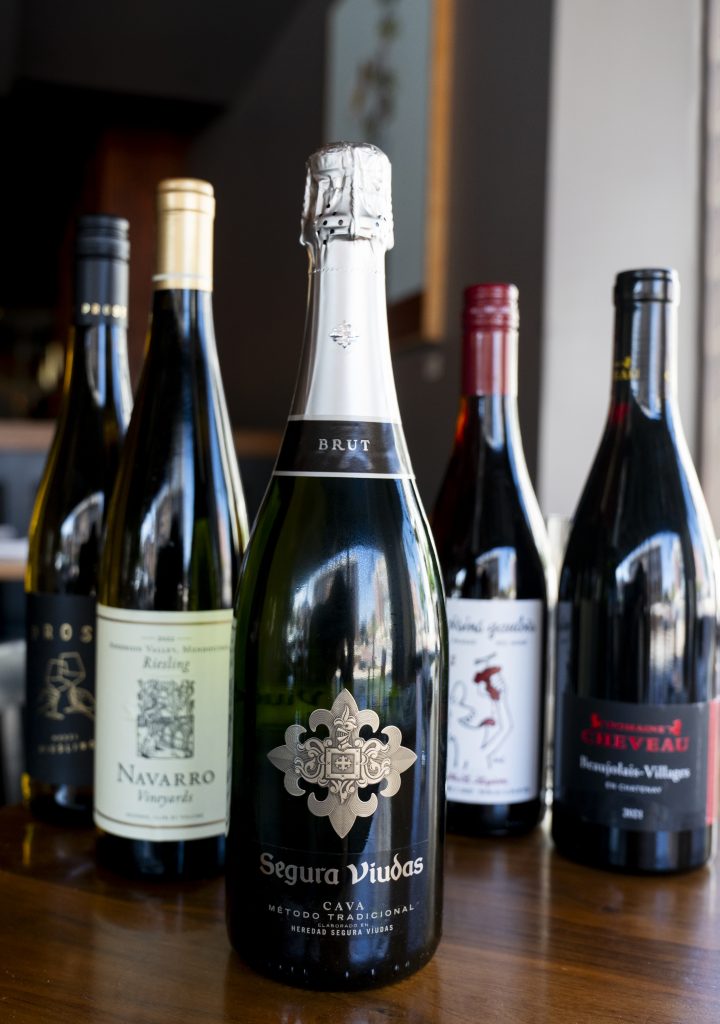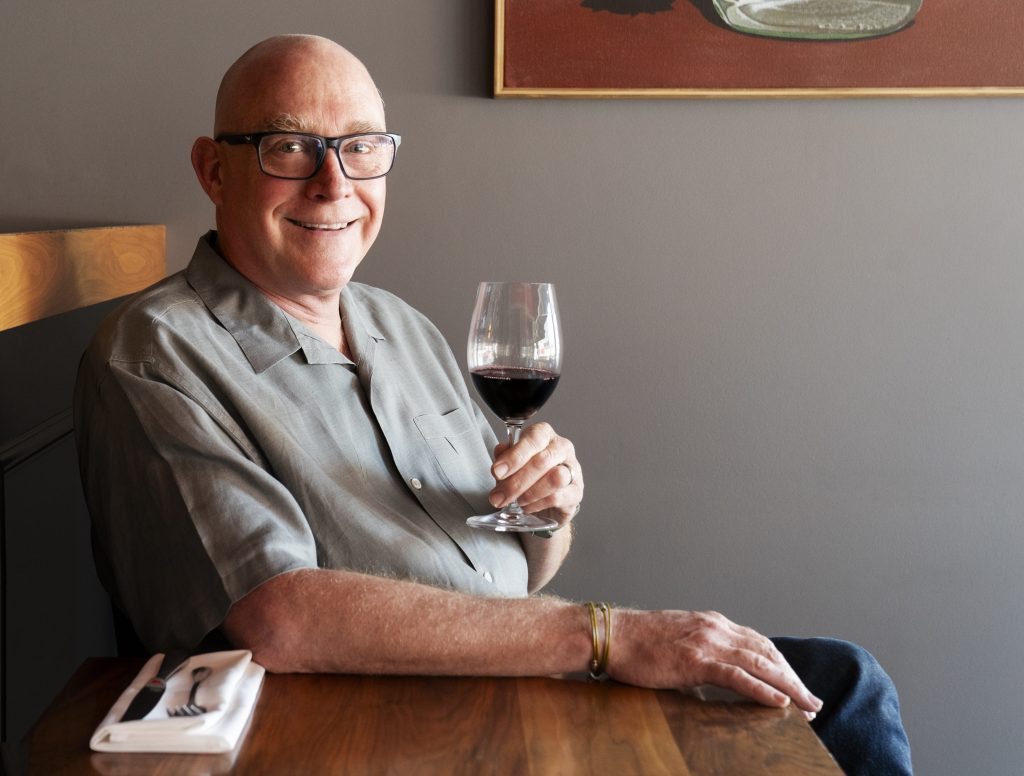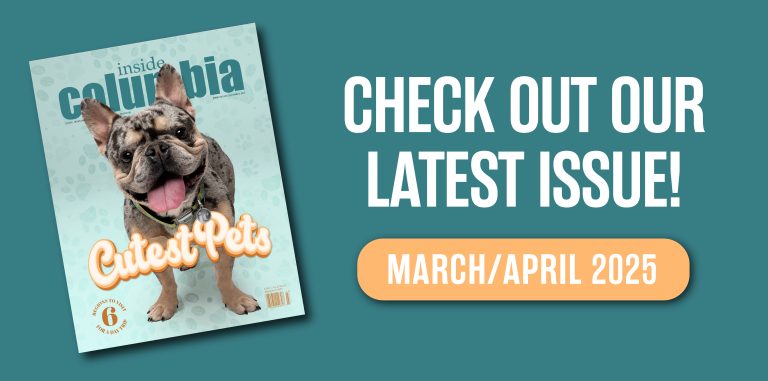Photos by L.G. Patterson
When I agreed to write this article about “fall wine,” I was thinking there is no such thing as “fall wine.” Then, while my wife and I were on a walk and I brought this up, she mentioned rosés. While rosés are certainly best in the summer — sitting outside with some friends and snacks, as though they are “summer wine” — people who make rosé don’t think of themselves as summer winemakers; they’re winemakers. Wineries don’t make “fall wine” or “spring wine.”

Thinking about wine always makes me think of food and which wine to pair with that food, so I approached this with food in mind. Obviously, the most important fall meal is Thanksgiving, so I thought about wine that pairs well with that holiday’s food. Thanksgiving is actually a very difficult meal to match wine to. This is primarily because most of us put all the food on the table at one time, instead of in courses where a different wine could be paired with each course. Think about the diversity of dishes many of us eat at Thanksgiving: cranberries, sweet potatoes, gravy and turkey, Brussels sprouts and green beans. It’s very hard to think of a wine that will complement it all.
My introduction to wine, as a kid, happened over the years primarily at Thanksgiving. I grew up in Mendocino, in northern California, and my grandparents lived in central California. Each year on their drive up for Thanksgiving, they would stop at wineries, taste, buy a few bottles and then arrive with a case or two. For the four or five days that they stayed with us, each night at dinner there would be multiple bottles opened. They would swirl and sniff while my dad just smiled and nodded, as he wasn’t discriminating. He used to say, and still believes, that “wine is good” … all wine. It was some years later that I was given some tastes, and it’s convenient that what I remember tasting first is a classic “fall” or Thanksgiving wine, gewurztraminer.
How perfect that the first wine I mention is a bit obscure and is definitely hard to pronounce: guhworse-trah-miner. The specific wine, Navarro Vineyards, inconveniently isn’t available here, but I grew up on Navarro Ridge in Mendocino County. It is about a half hour drive from the Anderson Valley, a great wine-growing area, where Navarro Vineyards is located. Beyond my sentimental reasons, gewurztraminer is good with Thanksgiving because its spiciness works with warm spices, but also with some vegetal qualities you will get with vegetables, alone, or in casseroles. If you’re interested in trying a spicy (think ginger), rich, sometimes a tiny bit sweet wine, go to any of the HyVee stores, Schnucks on Forum, Top Ten Wines, or Macadoodles, and they should be able to direct you to a gewurztraminer. The best examples will usually be from the Alsace region of France.
A slightly sweet and highly acidic Riesling is one of the most versatile wines with food. The sweetness can temper the fire of spicy food or match the sweetness in food, like cranberries for instance. Riesling’s acidity refreshes with each sip, begging you to sip again, and can cut through the richness of some food, like gravy or mashed potatoes. Riesling is one of the best Thanksgiving wines, and it is also one of the wines that many people say they don’t like. Usually, they think they don’t like it because it is sweet. The first wine most of us drank was sweet. Many of us have rejected sweet wines because they remind us of what we drank when we were learning about wine. It’s unfortunate. I dare you to come to Sycamore and try some pork belly sliders or Chris’s Nashville hot chicken with a glass of Riesling. For comparison’s sake ask for a sample of Cabernet and see which works better. If you know you’ll like the Cab and aren’t sure about the Riesling, order the Cab and get a sample of the Riesling! My favorite Rieslings come from the Mosel region of Germany. The Mosel is so far north that some years it isn’t warm enough for the grapes to ripen fully. These wines are naturally low in alcohol, sometimes dry but usually sweet, and high in acidity. You should be able to find a Riesling from the Mosel region of Germany at one of the stores mentioned above. You can find something delicious for around $15. Maybe you’ve seen “Kung Fu Girl” Riesling from Washington State? It’s very welldistributed, tasty and will fill in perfectly if you can’t find the Mosel Riesling.
Champagne is an obvious choice. It is celebratory by nature, and it pairs beautifully with most everything. Champagne is expensive. There are a lot of sparkling wines that aren’t Champagne (must be from the Champagne region of France to be “Champagne”) but are fantastic in their own right. Just about any Cava, which is sparkling wine from Spain, and can cost as little as $12 a bottle, will be quite satisfying. Marques de Caceres, and Segura Viudas are both Cava brands that are widely distributed. “Cremant” is a type of sparkling wine from regions of France other than Champagne. It is made in the same way as Champagne but is much less expensive. You might find examples from Burgundy, the Loire, or Alsace, and each will be made with the grapes common to their areas.
My parents, who still live in Mendocino, where I grew up, regularly go wine tasting in the Anderson Valley. The Anderson Valley is much less developed and has much less prestige than the Napa Valley, while still producing great wine. It can be expensive to go to wineries in Napa to taste. Most wineries in Anderson Valley offer tasting for free. But, not Roederer Estate, which is a great domestic sparkling wine, and so my father has never ponied up to taste at Roederer — he’s not cheap, but he certainly has his principles, and paying to taste doesn’t fit. Roederer is a French company that has a facility in the Anderson Valley that makes California sparkling wine. I highly recommend it. Roederer Estate is much less expensive than Champagne and a bit more expensive than Cava.
To me, Beaujolais is an obvious choice. It’s delicious! Beaujolais is a region south of Burgundy, in France, and the primary grape is Gamay. I’m not talking about Beaujolais Nouveau, which is sold as a celebration of the harvest when the wine is just made and hasn’t aged at all. I’m talking about Beaujolais Villages, or better yet, Cru Beaujolais. Cru Beaujolais is from 11 distinct regions within Beaujolais. These wines are much fuller-bodied, deeper in flavor and texture, and more serious than the nouveau versions. They often have a spicy quality combined with bright fresh, sometimes a bit wild, fruit flavors, and a bit of earth. When I say “earth” don’t get scared! Imagine driving around the countryside and what it smells like when you pass small farms: turned earth, the sun on corn and just the tiniest hint of the fact that cows and pigs live there. It’s not a bad smell, but it is an evocative smell. It’s the earthy and vegetal qualities, along with acidity, that helps a wine match food, and Beaujolais has those in spades. There should be an example or two at the grocery stores, but Paul at Top Ten will have a variety for you to consider.
Fall wine, for many people, would mean leaving the light refreshing wine of summer behind and switching to fullerbodied and more richly flavored wine for the cooler months. Contrast sitting on a patio during the summer sipping a glass of Sauvignon Blanc with sitting around a fire in the fall sipping a glass of Cabernet. At Sycamore, we sell much more white wine during the spring and summer and more red during the fall and winter. This contradicts assertions I’ve made elsewhere in this article, but there is nuance. The white wines we sell the most of in the summer are also the white wines we sell the most of in winter. It’s the same for the red wines; we just switch over all sales of each, red and white, seasonally. This is true for liquor as well. We sell more gin, tequila and vodka in the warm months and more brown liquor in the colder months.
This is going to sound really obvious: most people drink what they like, regardless of the season, and regardless of what they are eating. I think this is how it should be, but I hope everyone tries something new every once in a while. At Sycamore, regular customers often ask me to pair a wine with their dinner. With a couple of these people, it became a joke for me because whatever they were eating, and whatever I suggested, they would always choose the same type of wine they always drank. I wasn’t offended, and I would always bring a sample of my suggestion. I regularly encounter people who brand themselves as “a Cab guy” or “a Pinot person” or “I only drink Chardonnay.” To each their own is what I think. But I also think they are missing out. There are great interesting wines from all over the world. I tell my staff that they don’t have to like or care about wine but that they should learn something about the wine on my list to be able to talk about what they are selling. Each bottle could have a story behind it that includes generations of a family farming the same land, getting through wars (Europe), dealing with bureaucracy, adjusting to changes in tastes and fashion, all the while creating a product that represents their priorities, influenced by what the geology and geography of their place has to offer. When you are interested, curious, it becomes easy to learn. As a server, when you can talk about a wine it’s much easier to sell it. As a consumer, if you learn about a wine, your enjoyment of it takes on new dimensions. Cheers!







